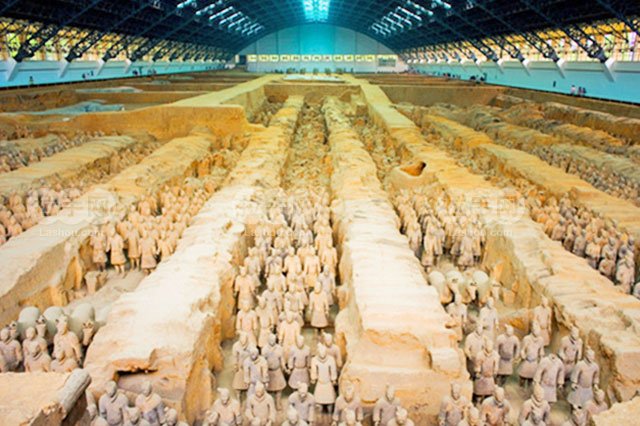Mausoleum of Emperor Qin Shihuang and Terra-cotta Warriors
秦始皇陵及兵马俑
Emperor Qin's mausoleum is the largest of ancient China, situated at the northern foot of Mt Li, Lintong County, some 30m east of Xi'an city,
秦始皇的陵墓是古代中国最大的,位于北部的临潼县骊山脚下,西安以东约30 m处,
facing Weishui River in the north,close to the tourist resort Huaqing Pool in the west.
面朝在北面的渭河,接近西面的华清池旅游胜地。
The huge and amazing satellite pit of terra-cotta warriors is 1 500m east of the mausoleum,discovered in March of 1974,by a group of farmers drilling a well against the draught.
巨大的、令人惊叹的兵马俑卫星坑在陵墓以1 500米处,1974年3月由一群钻井抗旱的农民发现。
Archaeologist the unearthed the treasure of Qin dynasty hidden for over 2 000 years.
考古学家发掘了在地下隐藏2 000年的宝藏,
The pit is truly an underground military museum largest worldwide.
坑确实是世界最大的地下军事博物馆。
Its design is rational and unique with a weight wall every 3m,dividing the 5m deep pit into lanes of warriors neatly arrayed.
其设计是理性的和独特的,每3米有重墙,把5米深坑里整齐排列的战士划分开。

Due to its hugeness and the lack of written data,Chinese archaeologists and historians have worked on the mausoleum for decades.
由于它的宏大和缺乏书面数据,中国考古学家和历史学家研究陵墓已经有几十年的的时间了。
Full scale excavation is left to the future, except some scientific unearthing of a few satellite pits,and visitors to the tomb see only a hill like mound.
全面挖掘留给未来,除了一些科学发掘一些卫星坑,游客到墓丘只能看到冰山一角。


